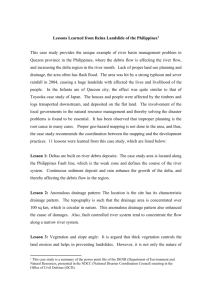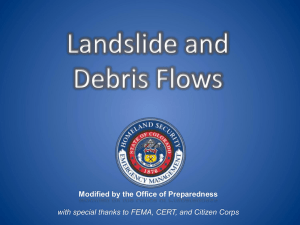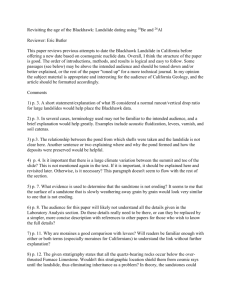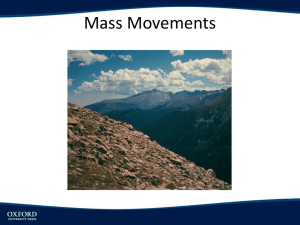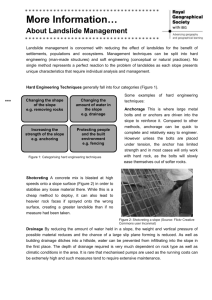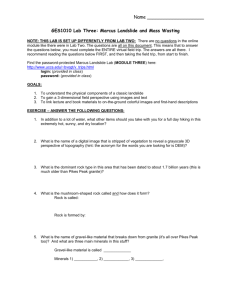Landslides and mass wasting
advertisement
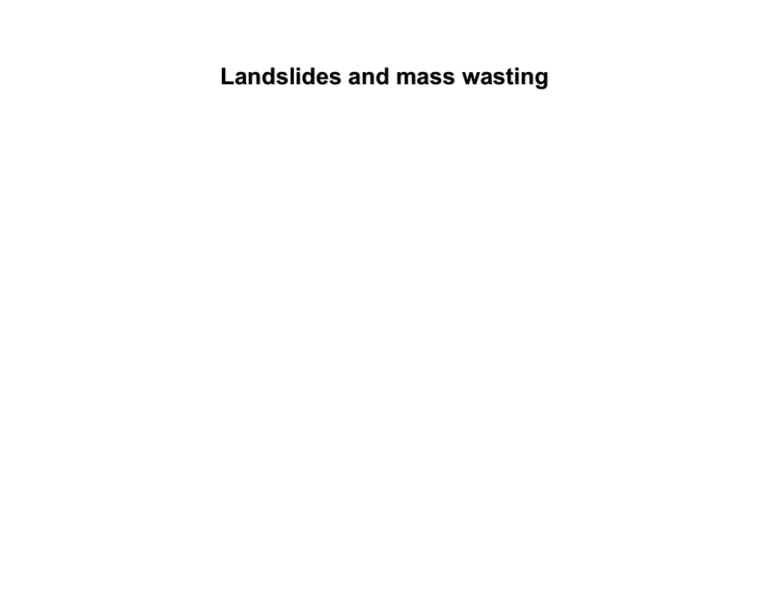
Landslides and mass wasting Mass Movements Areas of mass movement problems. Note areas in NY. From “Geohazards” by N. Coch. The helderberg escarpment is an example of a mass wasting prone area in New York. The shawangunk mountains are another example of an area prone to mass wasting in New York. Types of Mass movement: •Creep •Solifluction •Rock glaciers •Slumping •Mud- and debris flows •Landslides •Avalanches •Rock and debris falls “Portrait of a Planet” by S. Marshak Rock fall Debris avalanche Rockslide Mudflow & Debris flow Slump Solifluction & Creep Very slow Very fast ment e v o m s f mas o y t i c o l e Typical v Slide Slide Mass movements can be broadly divided into falls, slides, and flows From “Environmental Geology” by Pipkin A landslide will move if the driving force (d, due to gravity) exceeds the resistance force (f x n). f is a material property (coefficient of friction) -- values for various soils and rocks are available based on lab measurements. n is the component of gravity oriented normal to the slide surface. **Water in pores is under pressure (pore pressure) from the weight of overlying groundwater -- it thus acts to “buoy up” the slide, essentially reducing n and thus allowing sliding (or other mass movements) to occur under lower driving force. Increasing slope increases driving force d, thus making sliding more likely. Angle of repose: The angle of the steepest slope that a pile of uncemented material can attain without collapsing from the pull of gravity. As this angle is exceeded, the slope will fail, causing mass wasting. Creep: gradual movement of soil and rock downslope under the influence of gravity and annual freeze-thaw cycles. Tell tail signs of soil creep are tilted fences, poles, gravestones, bent or curving trees, foundation cracks in buildings, and soil encroachment onto pavement. “Portrait of a Planet” by S. Marshak Solifluction: earth flow found in periglacial environments underlain by permafrost. During the summer the surface layer of permafrost melts creating a watersaturated layer that becomes mobile. The underlying frozen ground acts as a sliding plane along which the mass of soil can slowly move down slope over. Permafrost: Permanently frozen ground. Rock glaciers: lobate mixture of rock fragments and ice with rock fragments out numbering ice. They move downslope slowly as the ice slowly recrystallizes. Slumping: soil slips downward along a sliding surface that is concave up, giving the impression that the mass has been scooped out. Scarp Former slope “Portrait of a Planet” by S. Marshak Toe of slump Physical features of a slump Slump in southern CA. Note the broken and displaced road. Landslides are common along coasts due to steepening of slopes by waves. Slump-earthflow, east of San Francisco Bay This is a very common type of landslide, with slumping at the top, and the lower part flowing. This landslide was almost certainly triggered by deep roadcuts made during construction of the freeway. To stabilize this area, the entire landslide was removed -- removing just part on the highway would result in additional future sliding. Small landslide covering a road Mudslide in CA, induced by heavy rains. Mudflow: A downslope movement of a mud water mixture. Usually occurs after heavy rainfall, and in areas of little vegetation. Debris flow: downslope movement of mud mixed with larger rock fragments. Lahars: A mud or debris flow formed when volcanic ash and debris mix with water, either in rivers or from rain or melting snow and ice on the flank of a volcano. MUDFLOWS Mudflow in Rio de Janeiro, Brazil “Portrait of a Planet” by S. Marshak Volcanic mudflow (lahar) in Columbia buried this town in 15 meters of mud, killing 20,000 people! Volcanic mudflow (lahar) below Mt. St. Helens, Washington Mudflow in Nevada mountains. This flow may be sufficiently rocky to be classified as a debris flow (>20% rock fragments) Landslide: A sudden downslope movement of rock and debris down a slope. Rock slide: a landslide that only consists of rock. Debris slide: a landslide that consists of both soil and rock. Landslide scar: barren surface that forms after a landslide occurs. Debris pile: pile at the base of the slope that consists of the material produced by the landslide. “Portrait of a Planet” by S. Marshak Landslide in California on U.S. 101 in 1995 that destroyed 9 houses, but no deaths or injuries. The road cut on the highway may have been important in causing this landslide. Other factors include weakness of material and water content. Landslide in Hong Kong that destroyed buildings. As in slide to left, note road built at level of uppermost tall buildings (arrow) Top of landslide triggered by earthquake in southern California Landslide triggered by heavy rains in southern California. It is likely the slope was over steepened during construction of the highway. slump Landslide in ~10,000 year-old lake clays near Glens Falls, NY. Slump-mudflow(earthflow). These lake clays occur up and down the Hudson Valley. mudflow Roadcut showing glacial till on sandstone bedrock, west of Albany. Tills in upstate NY are typically clay rich and prone to landsliding. This is a “transported soil”. Slide scar Vaiont dam Landslide deposit 1963 Vaiont landslide: 1900 lives lost, water built up by the dam caused the slope failure, 400 million cubic yards of debris slid off slope, after smaller slides had already occurred. Displaced 67 million cubic yards of water, the wave was 650 foot high wave. Extent of landslide damage caused by the Vaiont Dam landslide. Cross section of A to A’ line from diagram from the left. Slide scars Bedding surface Wave produced was >200 m high! Slide scars Landslide deposit Dam is behind here More photos of Vaiont Dam landslide

